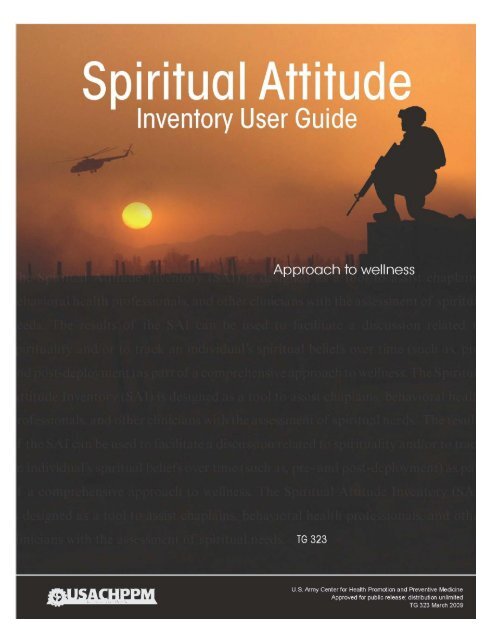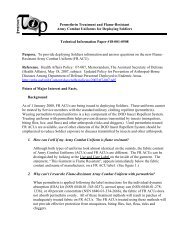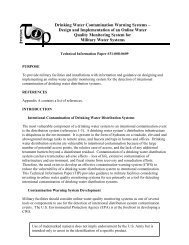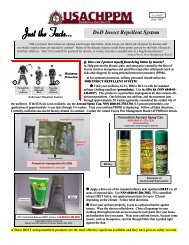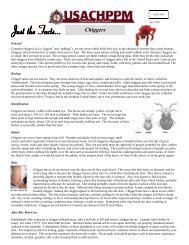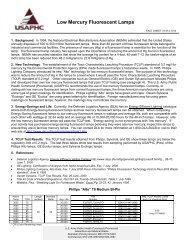Spiritual Attitude Inventory (SAI) - U.S. Army Public Health Command
Spiritual Attitude Inventory (SAI) - U.S. Army Public Health Command
Spiritual Attitude Inventory (SAI) - U.S. Army Public Health Command
You also want an ePaper? Increase the reach of your titles
YUMPU automatically turns print PDFs into web optimized ePapers that Google loves.
ACKNOWLEDGMENTS<br />
US <strong>Army</strong> Center for <strong>Health</strong> Promotion and Preventive Medicine (USACHPPM) POC:<br />
Psychologist<br />
Directorate of <strong>Health</strong> Promotion and Wellness<br />
Commercial Phone: (410)-436-2303/4654 DSN 584-2303/4654<br />
E-mail: DHPWWebContacts2@amedd.army.mil<br />
USACHPPM<br />
5158 Blackhawk Road<br />
Aberdeen Proving Ground, MD 21010<br />
The views expressed herein are the views of the authors and do not reflect the official policy of the<br />
Department of the <strong>Army</strong>, Department of Defense, or the U.S. Government. Human subjects<br />
participated in these studies after giving their free and informed voluntary consent. The U.S. <strong>Army</strong><br />
Medical Research and Material <strong>Command</strong> (MCMR), Office of Research Protections, Human Research<br />
Protection Office MCMR reviewed the human subjects protocol. Investigators followed the provisions<br />
of <strong>Army</strong> Regulation 70-25, Use of Volunteers as Subjects of Research, January 16, 2005. The<br />
USACHPPM <strong>Health</strong> Promotion and Prevention Initiatives (HPPI) Program provided the funding for<br />
the validation testing of the <strong>SAI</strong>. Use of specific validated measures of religion and spirituality in the<br />
<strong>SAI</strong> does not imply endorsement of those measures by the U.S. <strong>Army</strong> or Department of Defense.<br />
Permission was obtained from each of the following authors to use the scales that were combined to<br />
form the <strong>SAI</strong>.<br />
Harold Koenig, M.D.: Duke University Religion Index (DUREL)<br />
Raymond F. Paloutzian, Ph.D.: <strong>Spiritual</strong> Well-being Scale<br />
Kenneth Pargament, Ph.D.: Religious Coping Scale (NRCOPE)<br />
Kenneth A. Wallston, Ph.D.: Multidimensional <strong>Health</strong> Locus of Control Scale (MHLC)
TG 323 MARCH 2009<br />
TABLE OF CONTENTS<br />
1. PURPOSE AND SCOPE ............................................................................................................... 1<br />
2. BACKGROUND .......................................................................................................................... 1<br />
3. TEST ADMINISTRATION ............................................................................................................ 1<br />
APPENDICES:<br />
A REFERENCES ....................................................................................................................... A–1<br />
B SPIRITUAL ATTITUDE INVENTORY SCORING KEY ............................................................... B–1<br />
i<br />
Page
TG 323 MARCH 2009<br />
1. PURPOSE AND SCOPE.<br />
SPIRITUAL ATTITUDE INVENTORY<br />
USER MANUAL<br />
The <strong>Spiritual</strong> <strong>Attitude</strong> <strong>Inventory</strong> (<strong>SAI</strong>) is designed as a tool to assist chaplains, behavioral health<br />
professionals, and other clinicians with the assessment of spiritual needs. The results of the <strong>SAI</strong><br />
can be used to facilitate a discussion related to spirituality and/or to track an individual’s spiritual<br />
beliefs over time (such as, pre- and post-deployment) as part of a comprehensive approach to<br />
wellness.<br />
2. BACKGROUND.<br />
Research has shown that spirituality is positively associated with good physical and<br />
psychological health; however, the definitions of spirituality are varied. <strong>Spiritual</strong>ity is often used<br />
synonymously with religion. Traditionally, the definition of religion includes spirituality.<br />
However, in modern times, spirituality and religion have been separated (reference 1). Hill et al.<br />
(reference 2) argued that religion and spirituality are not independent constructs but are related.<br />
Many individuals experience spirituality in the context of an organized religious setting.<br />
<strong>Spiritual</strong>ity and religion both honor what is held sacred. <strong>Spiritual</strong>ity has been described as a<br />
search for the sacred, as well as a process through which people seek to discover, hold on to, and<br />
transform what they hold sacred in their lives (reference 3). Researchers agree that spirituality is<br />
an understudied variable in health research and that it is a moderately robust variable in<br />
predicting health-related outcomes (reference 4).<br />
3. TEST ADMINISTRATION.<br />
The <strong>SAI</strong> itself takes approximately 3–5 minutes to complete.<br />
A. PROCEDURE.<br />
Instrument Construction. The 28-item <strong>SAI</strong> was developed by combining four currently<br />
validated measures of religion and spirituality to address the following areas:<br />
Religious spiritual practice was measured by the Duke Religion Index (DUREL)<br />
(reference 5).<br />
1
TG 323 MARCH 2009<br />
Religious/spiritual belief was measured by the Negative Religious Coping (NRCOPE)<br />
scale (reference 6).<br />
Sense of purpose/connection was measured by the Existential Well-Being Scale (EWBS)<br />
(a subscale of the <strong>Spiritual</strong> Well Being Scale (SWBS) (reference 7).<br />
Sense of hope/control measured by the internal/external subscale of the Multiple <strong>Health</strong><br />
Locus of Control Scale (MHLC) (reference 8).<br />
Permissions. Permission was obtained from each of the authors to use the scales, and they were<br />
combined to form the <strong>SAI</strong>. Higher scores on the <strong>SAI</strong> indicate greater spirituality.<br />
B. MEASURES.<br />
The <strong>SAI</strong> is comprised of four validated scales.<br />
DUREL: Items 1– 5 on the <strong>SAI</strong>. This five-item scale is a measure of organized<br />
religiosity and the importance of religion in one’s life (reference 5). Internal consistency<br />
of this scale has been estimated at α = .85 among healthy adults (reference 9). High<br />
scores indicate high levels of religiosity.<br />
EWBS: Items 6– 15 on the <strong>SAI</strong>. The EWBS is a ten-item subscale of the SWBS<br />
designed to measure existential well-being (reference 7). Based on data from over 900<br />
participants in seven different studies, internal consistency coefficients of α = .73 to .98<br />
were reported (reference 10). Higher scores indicate greater existential well-being.<br />
NRCOPE: Items 16–22 on the <strong>SAI</strong>. This seven-item measure assesses negative religious<br />
coping described as having an ominous view of the world, an insecure relationship with<br />
God, and a struggle to find religious significance (references 6 and 11). Cronbach’s<br />
coefficient alpha (internal consistency) was estimated in three different samples: α = .78<br />
in a sample of individuals near the Oklahoma City bombing, α = .81 in a sample of<br />
college students, and α = .69 in an older hospitalized patient sample (reference 6). This<br />
scale was reverse scored for the purposes of the <strong>SAI</strong>, such that higher scores indicate<br />
lower levels of negative religious coping.<br />
MHLC: Items 23–28 on the <strong>SAI</strong>. The six-item internal/external subscale of the MHLC<br />
Scale assesses locus of control (reference 8). This subscale has reported internal<br />
consistency coefficients of α = .60 in a diverse Canadian sample (reference 12). Higher<br />
scores indicate endorsement of an internal locus of control.<br />
2
TG 323 MARCH 2009<br />
C. SCORING.<br />
The response to each item corresponds with a score (see “<strong>SAI</strong> Scoring Key” below). Adding the<br />
items’ scores together will result in a total score for the <strong>SAI</strong>. In addition to the total score, subscores<br />
for each of the four measures can be totaled. Scores can be useful for tracking change<br />
over time in an individual. In addition, the <strong>SAI</strong> administrator or counselor can choose to discuss<br />
responses to individual items on the <strong>SAI</strong>, facilitating a dialogue about spirituality and bolstering<br />
resiliency.<br />
<strong>SAI</strong> SCORING KEY<br />
<strong>SAI</strong>: (Items 1–28) Higher scores indicate greater spiritual beliefs.<br />
DUREL: (Items 1–5) Higher scores indicate higher levels of religiosity.<br />
EWBS: (Items 6–15) Higher scores indicate greater existential well-being.<br />
NRCOPE: (Items 16–22) Higher scores indicate lower levels of negative religious coping.<br />
MHLC: (Items 23–28) Higher scores indicate greater internal locus of control.<br />
FIGURE 1. <strong>SAI</strong> SCORING KEY<br />
3
TG 323 MARCH 2009<br />
APPENDIX A<br />
REFERENCES<br />
1. Koenig HG. 2001. Religion and medicine II: Religion, mental health, and related behaviors.<br />
Int J Psychiatry Med. 31:97-109.<br />
2. Hill PC, et al. 2000. Conceptualizing religion and spirituality: Points of commonality, points<br />
of departure. J Sci Study Relig. 30:51-77.<br />
3. Pargament KI, et al. 2004. Religious coping methods as predictors of psychological,<br />
physical and spiritual outcomes among medically ill elderly patients: A two-year longitudinal<br />
study. J <strong>Health</strong> Psychol. 9:713-30.<br />
4. Hill PC, Pargament KI. 2003. Advances in the conceptualization and measurement of<br />
religion and spirituality. Implications for physical and mental health research. Am Psychol.<br />
58:64-74.<br />
5. Koenig HG, Meador KG, Parkerson G, Religion index for psychiatric research: A 5-item<br />
measure for use in health outcome studies. Am J Psychiatry. 1997; 154:885-86.<br />
6. Pargament KI, Koenig HG, Perez LM. 2000. The many methods of religious coping:<br />
Development and initial validation of the RCOPE. J Clin Psychol. 56:519-43.<br />
7. Paloutizian RF, Ellison CW. 1982. Loneliness, spiritual well-being and the quality of life, in<br />
Loneliness: A Sourcebook of Current Theory, Research and Therapy, L.A. Peplau and<br />
D.Perlman, Editors. , Wiley-Interscience: New York. p. 224-37.<br />
8. Wallston KA. 2005. The validity of the multidimensional health locus of control scales. J<br />
<strong>Health</strong> Psychol. 10:623-31.<br />
9. Sherman AC, et al. 2001. Measuring religious faith in cancer patients: Reliability and<br />
construct validity of the Santa Clara Strength of Religious Faith Questionnaire. Psychooncology.<br />
10:436-43.<br />
10. Boivin MJ, et al. 1999. <strong>Spiritual</strong> Well-being Scale, in Measures of Religiosity, P.C. Hill and<br />
R.W. Hood, Editors. Religious Education Press: Birmingham, AL.<br />
A–1
TG 323 MARCH 2009<br />
11. Pargament K, et al. 1998. Patterns of positive and negative religious coping with major life<br />
stressors. J Sci Study Relig. 37:710-24.<br />
12. Chaplin WF, et al. 2001. A structural evaluation of the expanded Multidimensional <strong>Health</strong><br />
Locus of Control Scale with a diverse sample of Caucasian/European, Native, and Black<br />
Canadian women. J <strong>Health</strong> Psychol. 6:447-55.<br />
A–2
TG 323 MARCH 2009<br />
APPENDIX B<br />
SPIRITUAL ATTITUDE INVENTORY SCORING KEY<br />
B–1
TG 323 MARCH 2009<br />
Please answer the following questions by selecting the one answer that best describes how frequently you engage in the activities 1 …<br />
1 How often do you attend church or other religious or spiritual<br />
meetings?<br />
○6 More than once a week<br />
○5 Once a week ○6 More than once a day<br />
○4 A few times a month ○5 Daily<br />
○3 A few times a year ○4 Two or more times a week<br />
○2 Once a year or less ○3 Once a week<br />
○1 Never ○2 A few times a month<br />
○1 Rarely or never<br />
1 Items 1-5 are from the DUREL; Koenig, H. G , Meador, K , & Parkerson, G. 1997. Religion index for psychiatric research: A 5-item measure for use in health<br />
outcome studies. American Journal of Psychiatry, 154, 885-886.<br />
2 Items 6-15 are from the <strong>Spiritual</strong> Well-being Scale (only the existential well-being subscale is included); Paloutzian R. F., Ellison C. W. 1982. Loneliness,<br />
spiritual well-being, and the quality of life. In L. A. Peplau & D. Perlman (Eds), Loneliness: a sourcebook of current theory, research, and therapy (pp. 224-237).<br />
New York: Wiley-Interscience.<br />
B–2<br />
2 How often do you spend time in private religious or spiritual<br />
activities such as prayer, meditation, or the study of religious texts<br />
(e.g., Bible, Koran, Torah, etc)?<br />
For the following, use the scales provided to select the single answer that best characterizes how true each of the statements is for you…<br />
3 In my life, I<br />
experience the<br />
presence of the<br />
Divine (i.e., God).<br />
4 My religious beliefs are<br />
what really lie behind my<br />
whole approach to life.<br />
5 I try hard to carry my<br />
religion over into all other<br />
dealings in life.<br />
○5 Definitely True ○5 Definitely True ○5 Definitely True<br />
○4 Tends to be True ○4 Tends to be True ○4 Tends to be True<br />
○3 Unsure ○3 Unsure ○3 Unsure<br />
○2 Tends NOT to be True ○2 Tends NOT to be True ○2 Tends NOT to be True<br />
○1 Definitely NOT True ○1 Definitely NOT True ○1 Definitely NOT True<br />
Using the scales provided, indicate how much you agree or disagree with each of the following statements 2 …<br />
6 I don’t know who I<br />
am, where I came<br />
from, or where I’m<br />
going.<br />
7 I feel that life is a positive<br />
experience.<br />
○6 Strongly Agree<br />
8 I feel unsettled about my<br />
future.<br />
○1 Strongly Agree<br />
9 I feel very fulfilled and<br />
satisfied with life.<br />
○6 Strongly Agree<br />
○1 Strongly Agree ○5 Moderately Agree ○2 Moderately Agree ○5 Moderately Agree<br />
○2 Moderately Agree ○4 Agree ○3 Agree ○4 Agree<br />
○3 Agree ○3 Disagree ○4 Disagree ○3 Disagree<br />
○4 Disagree ○2 Moderately Disagree ○5 Moderately Disagree ○2 Moderately Disagree<br />
○5 Moderately Disagree ○1 Strongly Disagree ○6 Strongly Disagree ○1 Strongly Disagree<br />
○6 Strongly Disagree
10<br />
TG 323 MARCH 2009<br />
I feel a sense of wellbeing<br />
about the<br />
direction my life is<br />
headed in.<br />
Please use the scales provided to indicate how often, you have had thoughts or feelings like those described in the following<br />
statements 3 …<br />
16 I have wondered whether<br />
God has abandoned me.<br />
17 I have felt punished by<br />
God for my lack of<br />
devotion.<br />
B–3<br />
18 I have wondered what I<br />
did for God to punish<br />
me.<br />
19 I have questioned God’s<br />
love for me.<br />
○4 Not at All ○4 Not at All ○4 Not at All ○4 Not at All<br />
○3 Occasionally ○3 Occasionally ○3 Occasionally ○3 Occasionally<br />
○2 Frequently ○2 Frequently ○2 Frequently ○2 Frequently<br />
○1 A Great Deal ○1 A Great Deal ○1 A Great Deal ○1 A Great Deal<br />
20 I have wondered if my<br />
church has abandoned<br />
me.<br />
11<br />
I don’t enjoy much about<br />
life.<br />
21 I have decided the Devil<br />
is responsible for bad<br />
things that happen to<br />
me.<br />
22 I have questioned the<br />
power of God.<br />
○4 Not at All ○4 Not at All<br />
○3 Occasionally ○4 Not at All ○3 Occasionally<br />
○2 Frequently ○3 Occasionally ○2 Frequently<br />
○1 A Great Deal ○2 Frequently ○1 A Great Deal<br />
○1 A Great Deal<br />
3 Items 16-22 are from the Negative RCOPE; Pargament, K. I., Smith, B. W., Koenig, H. W., & Perez, L. 1998. Patterns of positive and negative religious coping<br />
with major life stressors. Journal for the Scientific Study of Religion, 37, 710-724.<br />
12<br />
I feel good about my<br />
future.<br />
13<br />
I feel that life is full of<br />
conflict and unhappiness.<br />
○6 Strongly Agree<br />
○1 Strongly Agree ○5 Moderately Agree ○1 Strongly Agree<br />
○6 Strongly Agree ○2 Moderately Agree ○4 Agree ○2 Moderately Agree<br />
○5 Moderately Agree ○3 Agree ○3 Disagree ○3 Agree<br />
○4 Agree ○4 Disagree ○2 Moderately Disagree ○4 Disagree<br />
○3 Disagree ○5 Moderately Disagree ○1 Strongly Disagree ○5 Moderately Disagree<br />
○2 Moderately Disagree ○6 Strongly Disagree ○6 Strongly Disagree<br />
○1 Strongly Disagree<br />
14<br />
Life doesn’t have<br />
much meaning.<br />
15<br />
I believe there is some<br />
real purpose for my life.<br />
○1 Strongly Agree ○6 Strongly Agree<br />
○2 Moderately Agree ○5 Moderately Agree<br />
○3 Agree ○4 Agree<br />
○4 Disagree ○3 Disagree<br />
○5 Moderately Disagree ○2 Moderately Disagree<br />
○6 Strongly Disagree ○1 Strongly Disagree
TG 323 MARCH 2009<br />
For each of the following statements, use the scales provided to indicate the extent to which you agree or disagree 4 …<br />
23<br />
If I get sick, it is my own<br />
behavior that determines<br />
how soon I get well again.<br />
24<br />
I am in control of my<br />
health.<br />
B–4<br />
25<br />
When I get sick I am to<br />
blame.<br />
○1 Strongly Disagree<br />
○2 Moderately Disagree ○1 Strongly Disagree<br />
26<br />
The main thing that<br />
affects my health is what I<br />
myself do.<br />
○1 Strongly Disagree ○3 Disagree ○2 Moderately Disagree ○1 Strongly Disagree<br />
○2 Moderately Disagree ○4 Agree ○3 Disagree ○2 Moderately Disagree<br />
○3 Disagree ○5 Moderately Agree ○4 Agree ○3 Disagree<br />
○4 Agree ○6 Strongly Agree ○5 Moderately Agree ○4 Agree<br />
○5 Moderately Agree ○6 Strongly Agree ○5 Moderately Agree<br />
○6 Strongly Agree ○6 Strongly Agree<br />
27 If I take care of myself, I<br />
can avoid illness.<br />
28 If I take the right<br />
actions I can stay<br />
healthy.<br />
○1 Strongly Disagree ○1 Strongly Disagree<br />
○2 Moderately Disagree ○2 Moderately Disagree<br />
○3 Disagree ○3 Disagree<br />
○4 Agree ○4 Agree<br />
○5 Moderately Agree ○5 Moderately Agree<br />
○6 Strongly Agree ○6 Strongly Agree<br />
4 Items 23-28 are from the IHLC scale of Form A of the Multidimensional <strong>Health</strong> Locus of Control Scale; Wallston, K. A., Wallston, B. S., & DeVellis, R. 1978.<br />
Development of the multidimensional health locus of control (MHLC) scales. <strong>Health</strong> Education Monographs, 6, 160-170.


